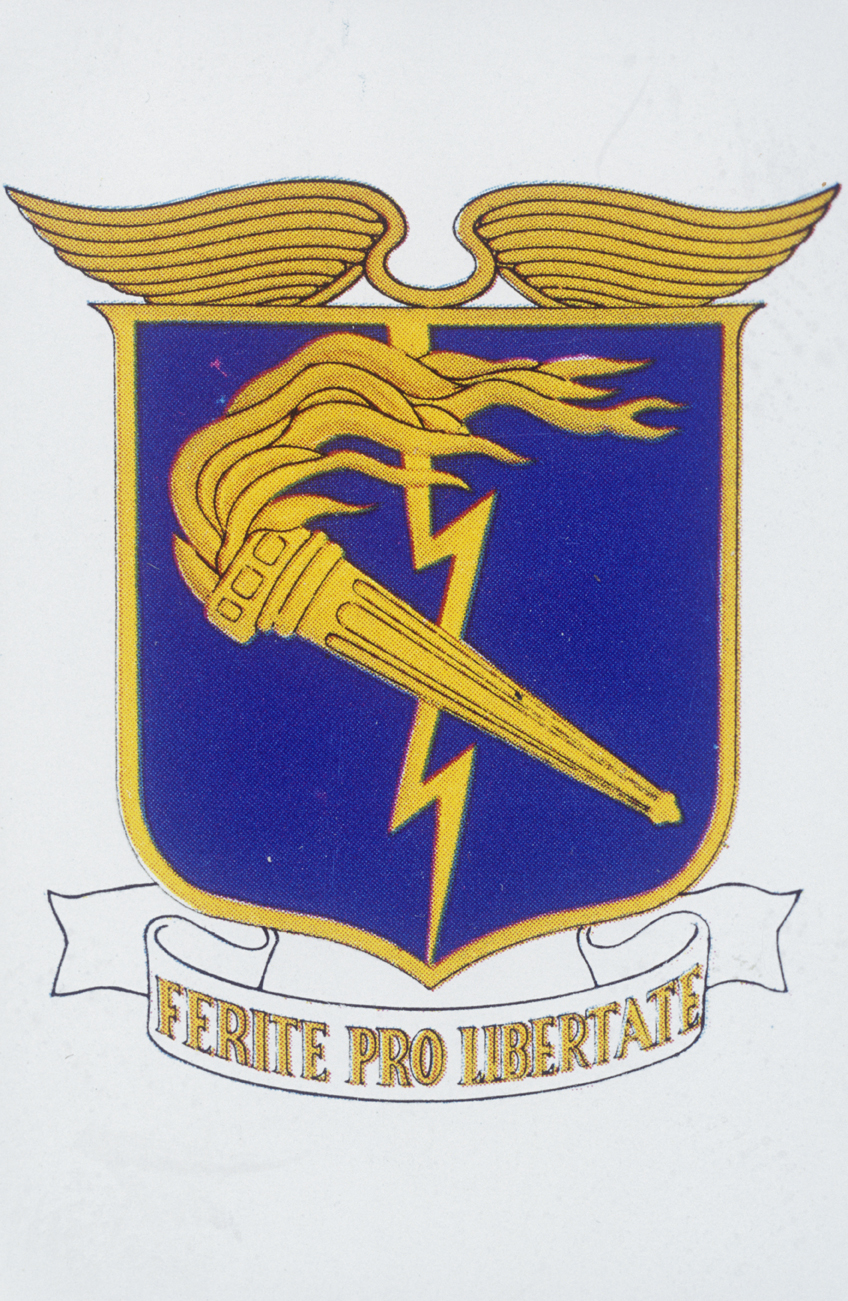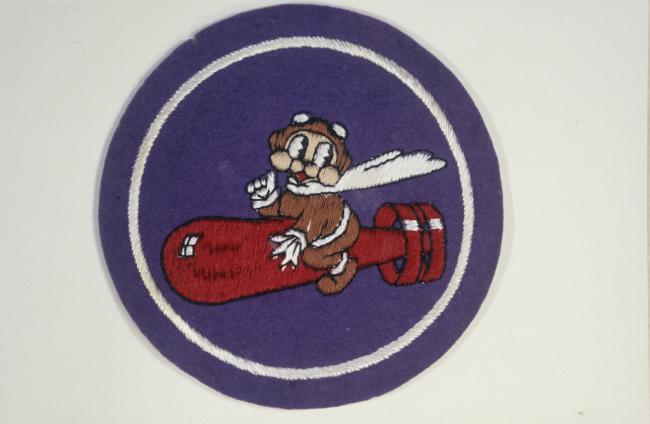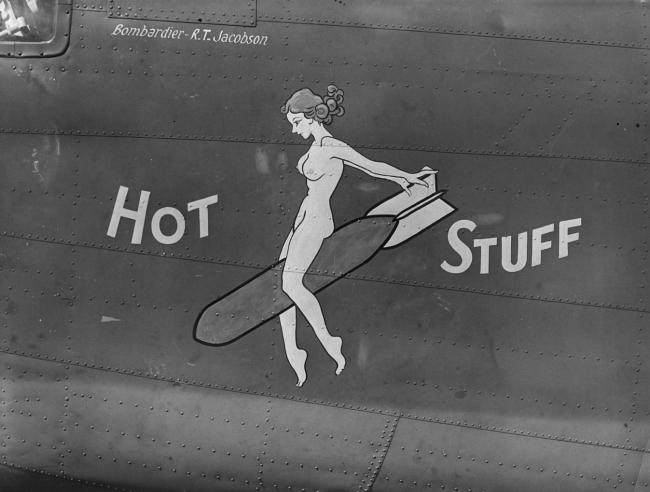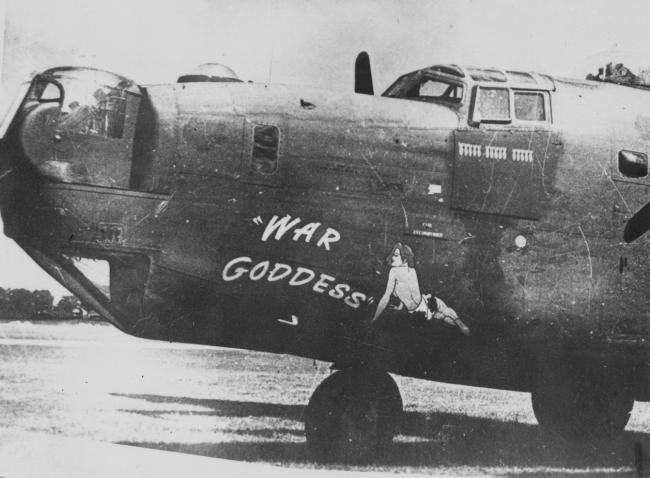93rd Bomb Group
Group
IWM, Roger Freeman Collection
Object Number - FRE 5080 - The insignia of the 93rd Bomb Group.
The 93rd Bombardment Group (Heavy) was activated 1 Mar 42 at Barksdale Field, Louisiana. On 15 May 42. the Group moved to Ft. Myers, Florida, to continue advanced flight training and also to fly antisubmarine patrols over the Gulf of Mexico. They claimed 3 U-Boats destroyed. Between 2-15 Aug 1942, the Group moved to Fort Dix, New Jersey to prepare for deployment overseas. The ground echelon departed for the U.K. on the Queen Elizabeth on 31 Aug 1942, and the air echelon moved to Grenier Field, New Hampshire, and was refitted with B-24Ds. The group was first located at Station 102, Alconbury between 6 Sep 1942, and 6 Dec 1942. The Group flew 396 missions in 8,169 sorties and dropped 19,004 tons of bombs with 100 aircraft MIA.
The 93rd Bomb Group was one of the three 8th Air Force B-24 groups that were detached (TDY) and sent to North Africa in support of 12th Air Force on 12 Dec 1942. The 329th Bomb Squadron remained behind and took up residence at Hardwick. The 32th Bomb Squadron, and the 330th Bomb Squadron and and the 409th Bomb Squadron flew to the initial station at Tafarouri, Algeria, but the field there was not suited for the heavy bombers, and they only conducted two missions from that field. They were then moved to Gambut Main, Libya, a field assigned to 9th Air Force. They remained there until 22 Feb 1943, at which time they returned to Hardwick until 26 Jun 1943.
In late June 1943 the Group was once again sent TDY to the 9th Air Force at Bengazi, Libya, for Operation Tidal Wave. They participated in the famous mission against the oil targets at Ploesti, Romania. 1 Aug 43. The Squadrons, then, returned to Hardwick, U.K., on 27 Aug 1943, and flew missions from that station until the Group was sent back to the United States on 12 Jun 45.
CLAIMS TO FAME:
Oldest B-24 Bomb Group in 8th Air Force
Flew most missions of any Group in 8th Air Force
First Bomb Squadron (329th) to penetrate German airspace 2 Jan 43
Most traveled Bomb Group in 8th Air Force
First heavy bomber to fly 25 missions: B-24, 41-23728, Hot Stuff, 330Bomb Squadron
First B-24 to complete 50 missions, Boomerang
Only wartime unit in the USAF that has not been inactivated since its original formation.
Browse the 93rd Bomb Group photographs and other documents in the 2nd Air Division Memorial Library digital archive here: www.2ndair.org.uk/digitalarchive/Dashboard/Index/50
Commanding Officers

- Military/Civilian/Mascot: Military
- Nationality: American
- Unit: 93rd Bomb Group Headquarters (93rd Bomb Group)
- Service Numbers: O-280827
- Highest Rank: Lieutenant Colonel
- Role/Job: Pilot / Commanding Officer

- Military/Civilian/Mascot: Military
- Nationality: American
- Unit: 20th Combat Bomb Wing 2nd Combat Bomb Wing 453rd Bomb Group 93rd Bomb Group
- Service Numbers: O-18619
- Highest Rank: Brigadier General
- Role/Job: Commanding General
- Military/Civilian/Mascot: Military
- Nationality: American
- Unit: 93rd Bomb Group
- Highest Rank: Colonel
- Role/Job: Commanding Officer

- Military/Civilian/Mascot: Military
- Nationality: American
- Unit: 20th Combat Bomb Wing 381st Bomb Group 93rd Bomb Group Headquarters (381st Bomb Group)
- Service Numbers: O-21383
- Highest Rank: Colonel
- Role/Job: Commanding Officer 93rd , Air Executive, Deputy Wing Commander
- Military/Civilian/Mascot: Civilian
- Nationality: American
- Unit: 93rd Bomb Group
- Military/Civilian/Mascot: Military
- Nationality: American
- Unit: 93rd Bomb Group
- Highest Rank: Lieutenant Colonel
- Role/Job: Commanding Officer

- Military/Civilian/Mascot: Military
- Nationality: American
- Unit: 93rd Bomb Group
- Service Numbers: O-001282A
- Highest Rank: Colonel
- Role/Job: Pilot
Connections
See how this entry relates to other items in the archive by exploring the connections below.
Unit stations
| Station | Location | Date |
|---|---|---|
|
Established |
1 March 1942 | |
|
Based |
Alconbury | 6 September 1942 - 6 December 1942 |
|
Based |
Hardwick | 6 December 1942 - 12 June 1945 |
Encompassing

- Unit Hierarchy: Squadron
- Air Force: Eighth Air Force
- Type Category: Bombardment

- Unit Hierarchy: Squadron
- Air Force: Eighth Air Force
- Type Category: Bombardment

- Unit Hierarchy: Squadron
- Air Force: Eighth Air Force
- Type Category: Bombardment

- Unit Hierarchy: Squadron
- Air Force: Eighth Air Force
- Type Category: Bombardment

- Unit Hierarchy: Headquarters
- Air Force: Eighth Air Force
People
- Military/Civilian/Mascot: Military
- Nationality: American
- Unit: 93rd Bomb Group
- Service Numbers: 35259492
- Highest Rank: Corporal (RAF)
- Military/Civilian/Mascot: Civilian
- Nationality: American
- Unit: 93rd Bomb Group
- Military/Civilian/Mascot: Military
- Nationality: American
- Unit: 93rd Bomb Group
- Military/Civilian/Mascot: Military
- Nationality: American
- Unit: 93rd Bomb Group
- Military/Civilian/Mascot: Civilian
- Nationality: American
- Unit: 93rd Bomb Group
Aircraft

- Aircraft Type: B-24 Liberator
- Nicknames: - Hot Freight
- Unit: 93rd Bomb Group 330th Bomb Squadron

- Aircraft Type: B-24 Liberator
- Nicknames: Double Trouble
- Unit: 93rd Bomb Group 328th Bomb Squadron

- Aircraft Type: B-24 Liberator
- Nicknames: Jerks Natural
- Unit: 93rd Bomb Group 328th Bomb Squadron

- Aircraft Type: B-24 Liberator
- Nicknames: Exterminator
- Unit: 93rd Bomb Group 329th Bomb Squadron 330th Bomb Squadron

- Aircraft Type: B-24 Liberator
- Nicknames: - Hot Stuff
- Unit: 93rd Bomb Group 330th Bomb Squadron
Mission

- Date: 11 March 1945

- Date: 24 December 1944
- Date: 30 August 1944

- Date: 26 August 1944

- Date: 25 August 1944
Revisions
Lee Cunningham 25-Nov-2014. Corrected Barksdale location from Florida to Louisiana.
Lee Cunningham 25-Nov-2015. Added early history and statistics per http://www.usaaf.com/8thaf/bomber/93bg.HTM.
Combined two entries for the 93rd Bomb Group into a single entry. This entry now includes information from the following contributors and sources:
Sam_Martin used 'Maurer, Maurer, Ed., Air Force Combat Units of World War II. U.S. Government Printing Office: Washington, D.C., 1961.'
Lee8thbuff used: http://www.usaaf.com/8thaf/bomber/93bg.HTM; http://www.93rdbombardmentgroup.com/historyfull.html;
Drawn from the records of the National Museum of the Mighty Eighth Air Force, Savannah, Georgia / Paul Andrews, Project Bits and Pieces, 8th Air Force Roll of Honor database / The Mighty Eighth. A History of the Units, Men and Machines of the US 8th Air Force.' by Roger A. Freeman (1989). 'Air Force Combat Units of World War II' compiled by the Department of the US Air Force, edited by Maurice Maurer (1983). / Units in the UK from ETOUSA Station List, as transcribed by Lt. Col. Philip Grinton (US Army, Retired) and extracted by IWM; air division data from L.D. Underwood, based on the 8th Air Force Strength Report of 6th August 1944, as published in 'The 8th Air Force Yearbook' by Lt. Col. John H Woolnough (1980)








![Ground personnel of the 93rd Bomb Group work on a B-24 Liberator nicknamed "Teggie Ann". Handwritten caption on reverse: 'USAAF 3, 93BG.' On reverse: US Army Press Censor [Stamp].](https://assets.americanairmuseum.com/s3fs-public/styles/max_650x650/public/freeman/media-408359.jpg?itok=XNPOo9oA)
![A B-24 Liberator (YM-M, serial number 42-50781) of the 93rd Bomb Group with an Aeronica L-3 Grasshopper. On reverse: Obscured SHAEF Field Press Censor [Stamp] and Associated Press Photo [Stamp].](https://assets.americanairmuseum.com/s3fs-public/styles/max_650x650/public/freeman/media-408361.jpg?itok=XLdcJQt3)